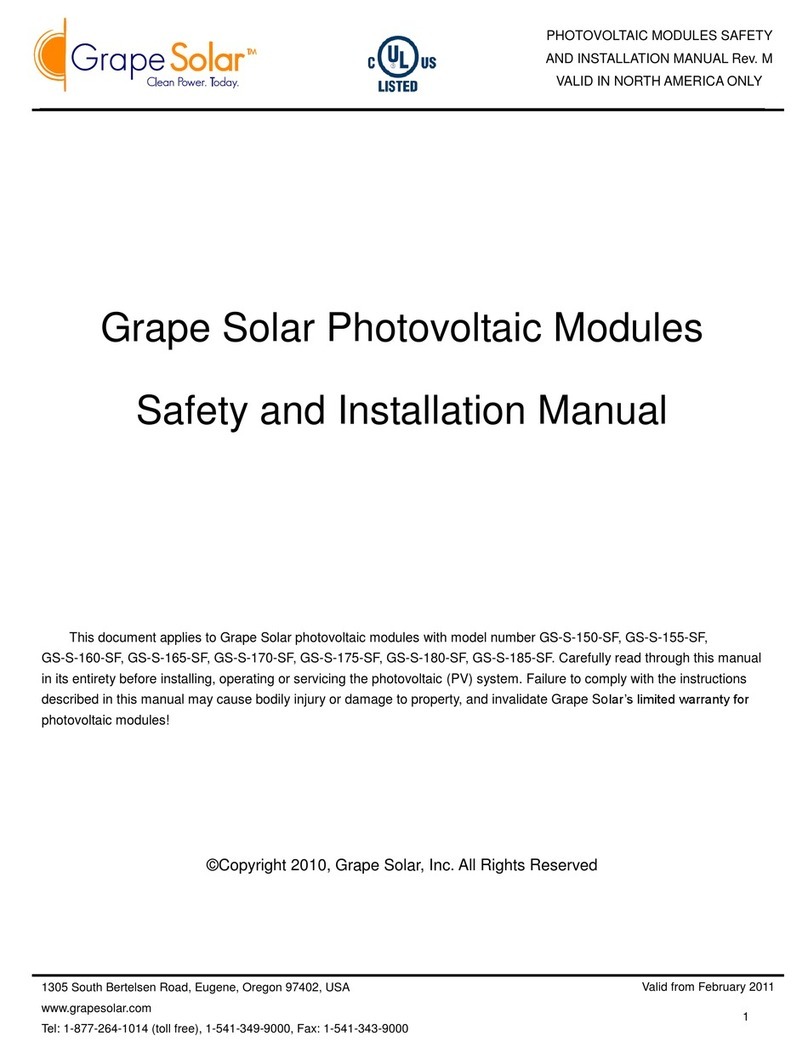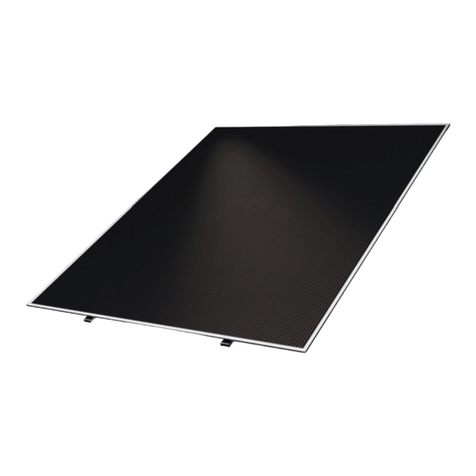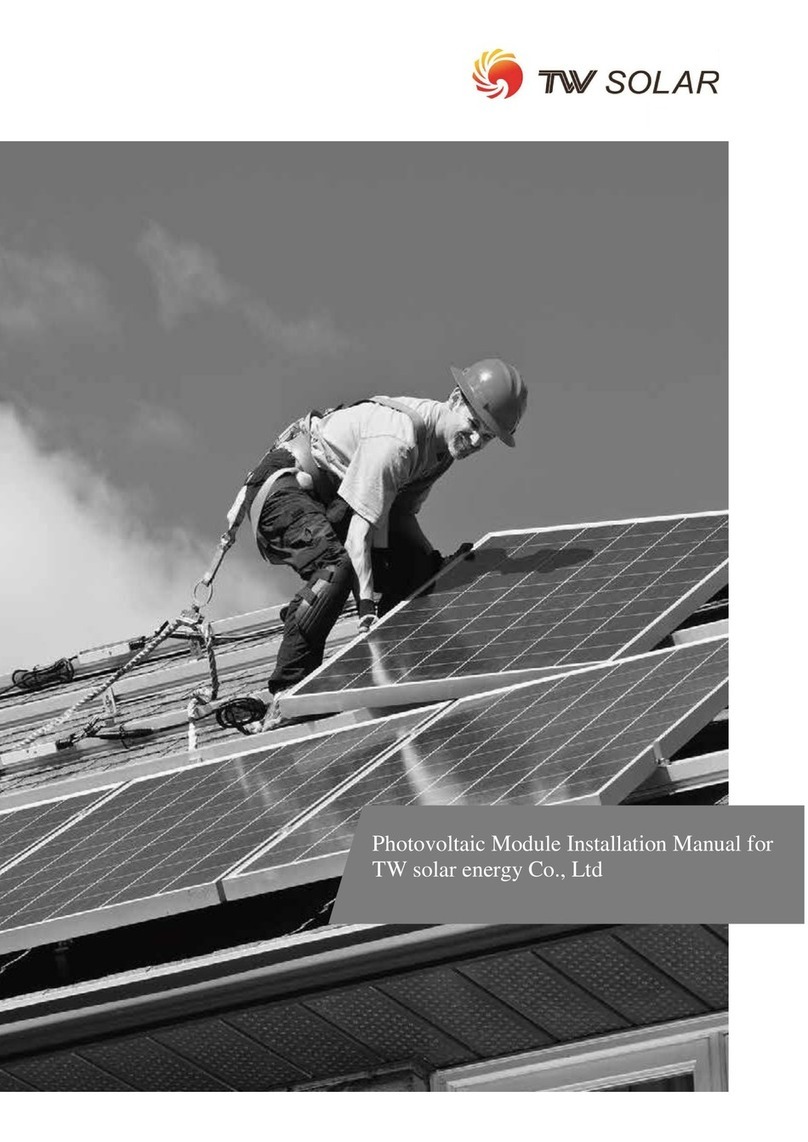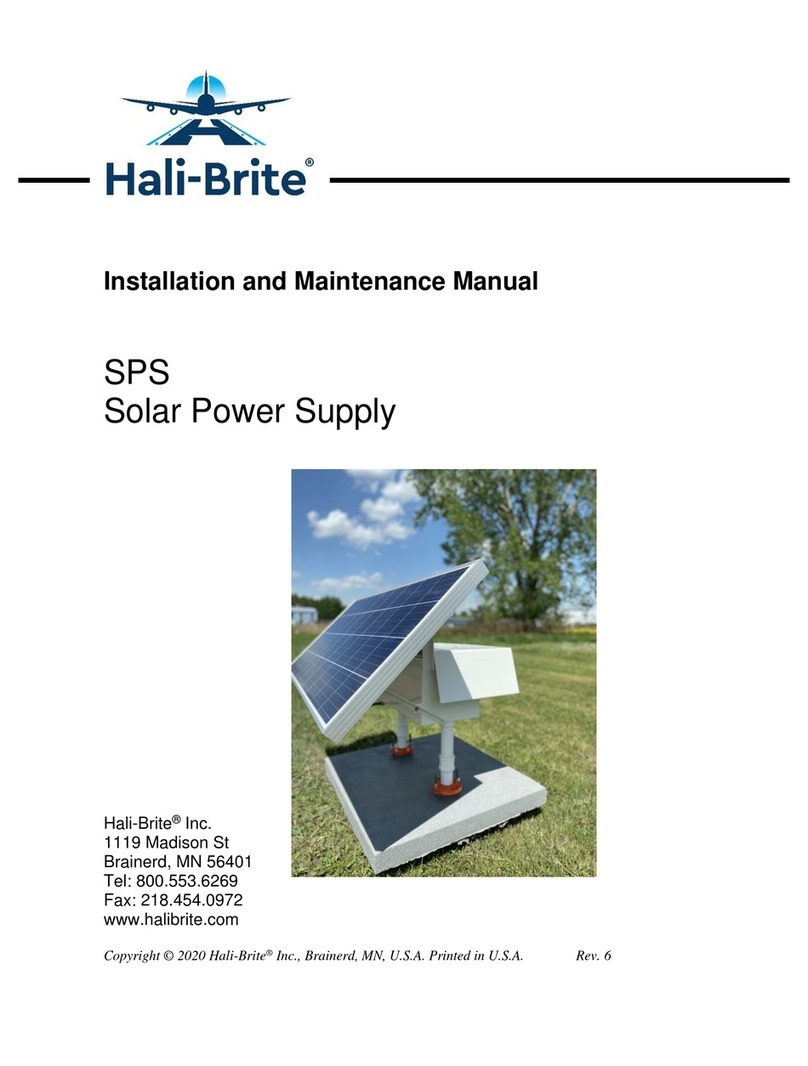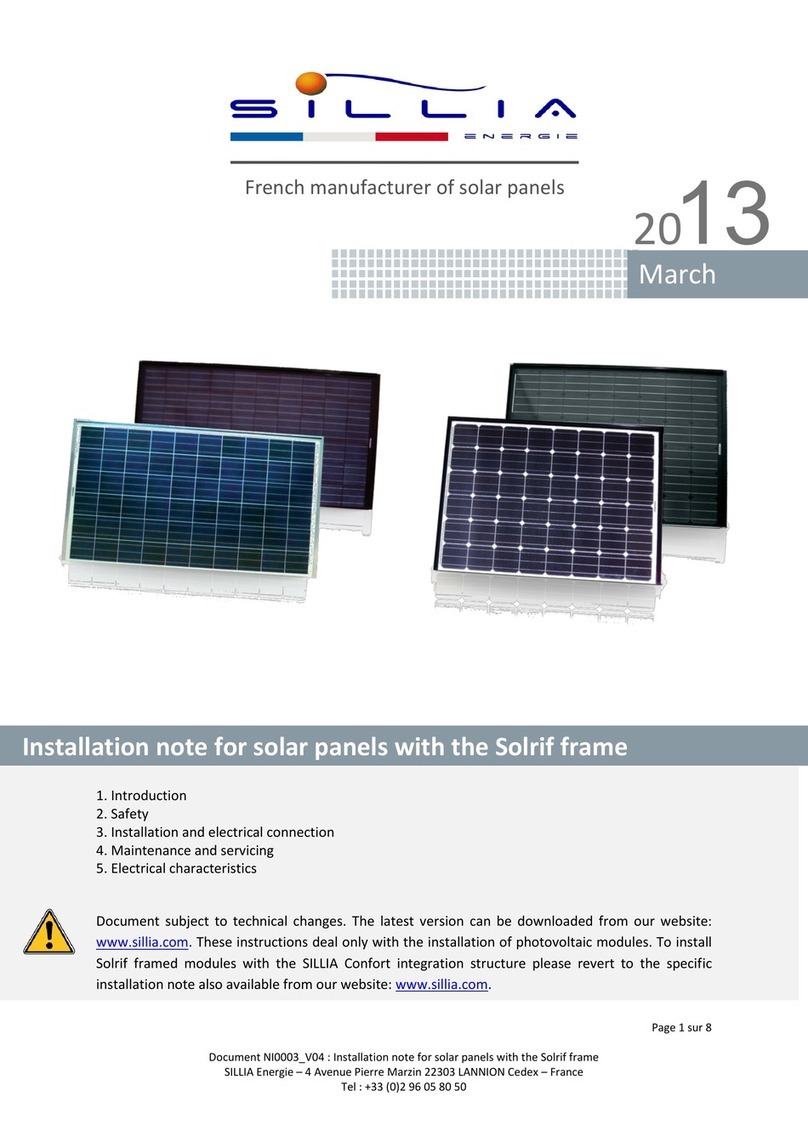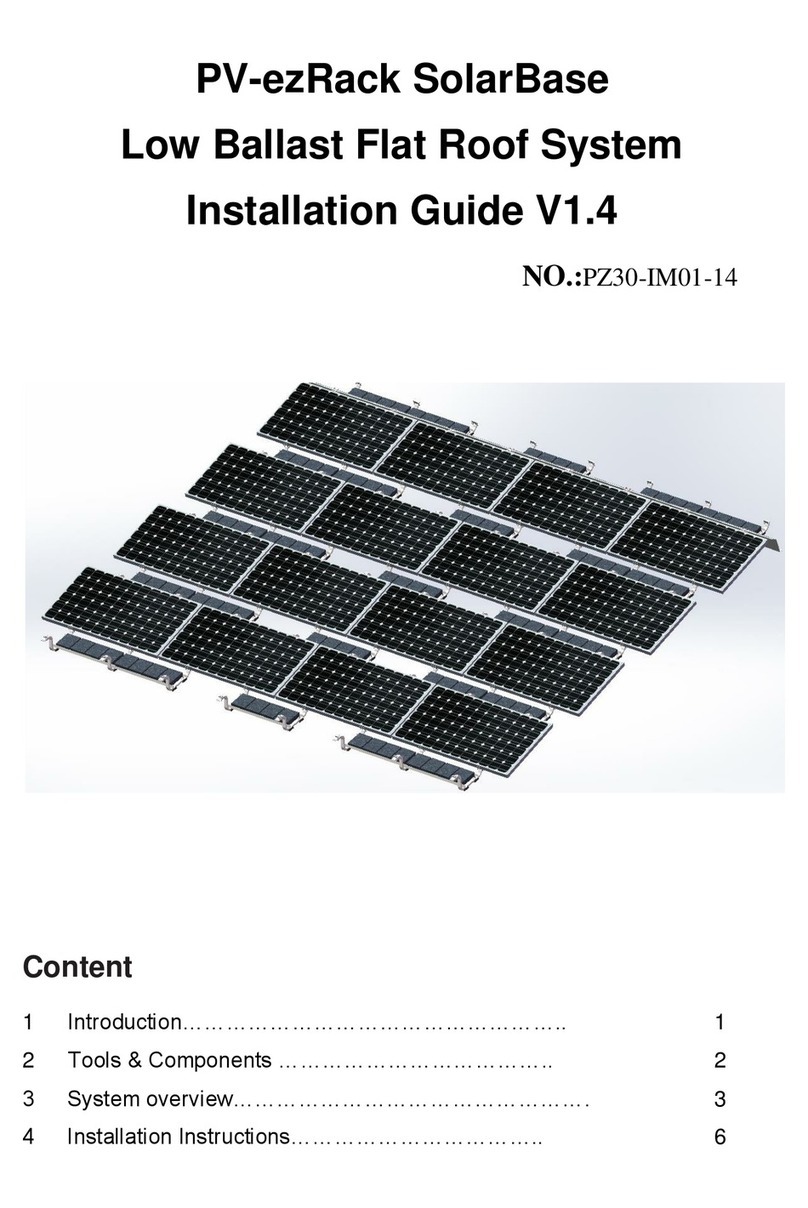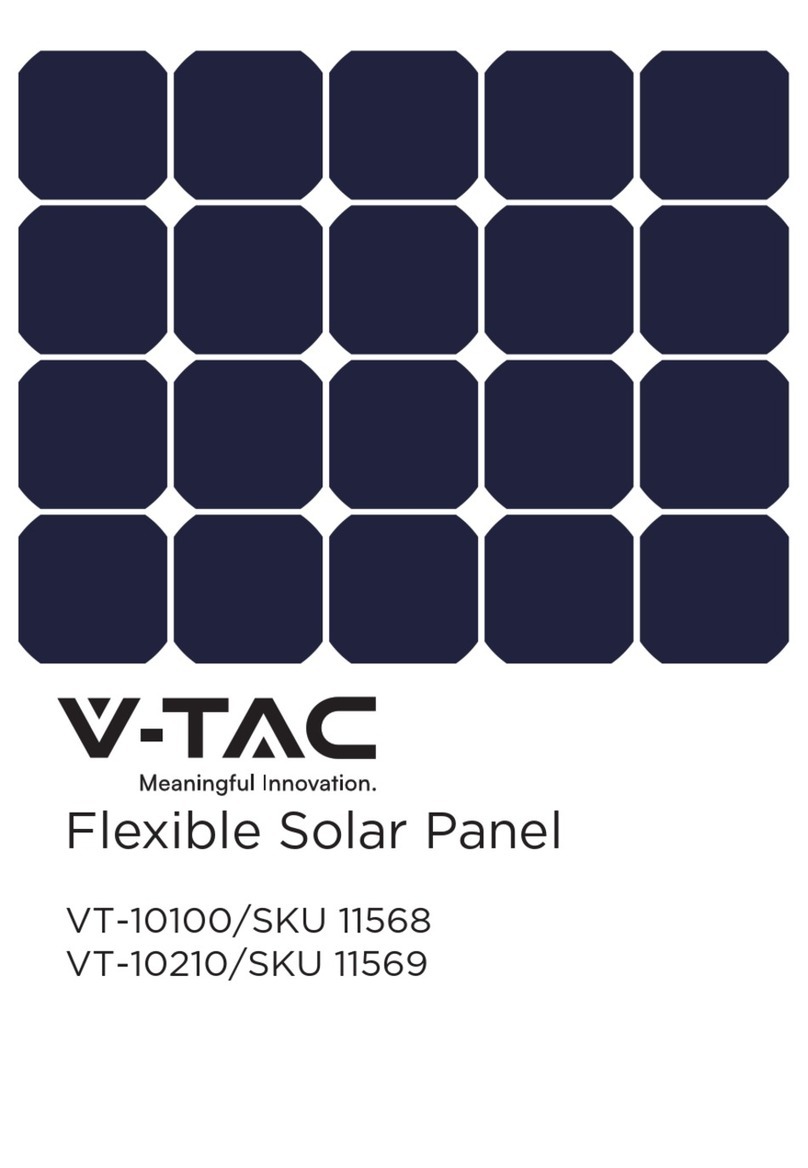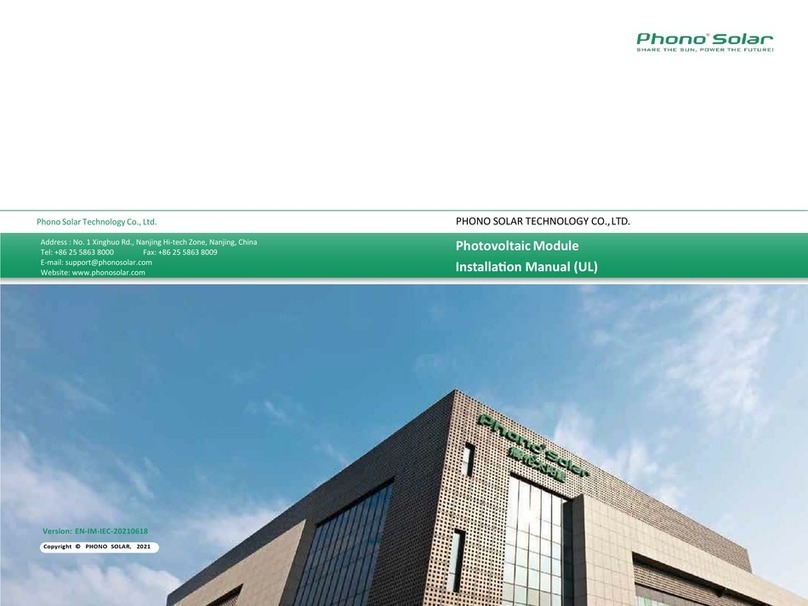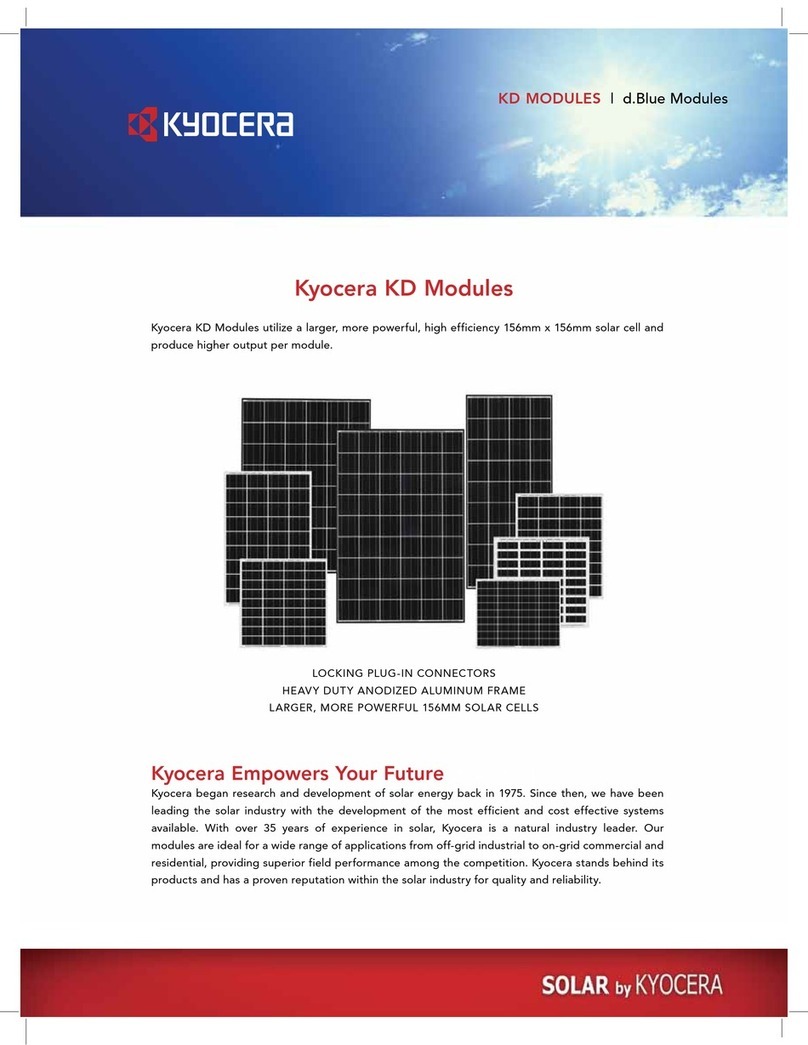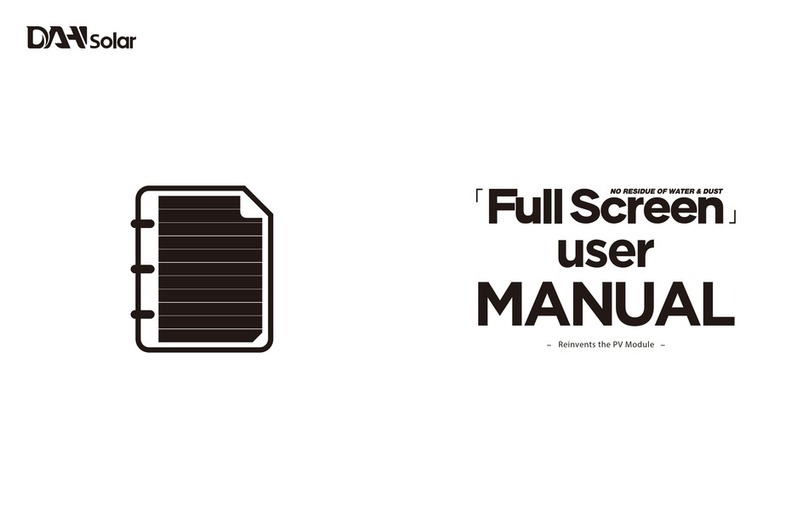Silfab Solar SLA M SERIES Mounting instructions

Safety & Installation Manual
Silfab Solar
Photovoltaic Modules:
SLA M SERIES, SLG M SERIES, SLA X SERIES, SLG X SERIES, SSA M SERIES, SSG M SERIES
JUST
-IN-
TIME
P
E
R
F
O
R
M
E
R
TOP
BAA
ARRA
Document Number: MAN-SFO-06 | SAFETY AND INSTALLATION MANUAL FOR PHOTOVOLTAIC MODULES

CONTENTS
Table of
Safety Notice
Installation Manual Disclaimer
General Information
3 Model Naming Overview
4 Disclaimer of Liability
Product Certification
Limited Warranty
Module Specifications
Safety Precautions
Installation
5 Module Mounting Overview
6 Module Mounting Method using mounting holes
6 Mounting using clamping method
Handling of Modules
10 Electrical Connection
11 Grounding
12 Silfab SLA X Bifacial Modules
13 Silfab Smart Modules
13 Marine applications
Document Number: MAN-SFO-06 | SAFETY AND INSTALLATION MANUAL FOR PHOTOVOLTAIC MODULES

Maintenance
Diagnostics &Troubleshooting
Module Identification
Packaging, Handling & Storage
15 Silfab's Packaging
16 Correct Handling of Module Packaging
17 How to Handle the Pallet
17 Unpacking Modules
17 Pallet Sheet
18 Recycling Packaging Materials
Revision Log
Document Number: MAN-SFO-06 | SAFETY AND INSTALLATION MANUAL FOR PHOTOVOLTAIC MODULES
Document Number: MAN-SFO-06 | SAFETY AND INSTALLATION MANUAL FOR PHOTOVOLTAIC MODULES

3
1. SAFETY NOTICE
This Safety and Installation Manual provides import-
ant safety information relating to the installation,
maintenance and handling of Silfab SLA/SSA and
SLG/SSG modules. Professional installers, operation
& maintenance technicians, and system users/own-
ers should read this manual carefully and strictly
follow the instructions. Failure to follow these
instructions may result in death, injury or property
damage, and possible void of warranty.
Please keep this manual for future reference.
We recommend checking www.silfab.ca regularly for
the most updated version.
Warning: All instructions should be read and under-
stood before attempting to install, wire, operate
and/or maintain the module. Module interconnects
pass direct current (DC) when exposed to sunlight or
other light sources. Contact with electrically active
parts of the module, such as terminals, can result in
injury or death, whether the module is connected or
disconnected.
Avertissement: Toutes les instructions devront être
lues et comprises avant de procéder àl’installation, le
câblage, l’exploitation et/ou l’entretien des panneaux.
Les interconnexions des panneaux conduisent du
courant continu (CC) lorsque le panneau est exposé
àla lumière du soleil ou àd’autres sources lumineus-
es. Tout contact avec des éléments sous tension du
panneau tels que ses bornes de sortie peut entraîner
des blessures ou la mort, que le panneau soit
connectéou non.
2. INSTALLATION MANUAL DISCLAIMER
The information contained in this manual is subject to
change by Silfab Solar Inc. without prior notice. Silfab
Solar Inc. gives no guarantee of any kind whatsoever,
either explicitly or implicitly, with respect to the
information contained herein. This Manual (or docu-
ment) is written in English with Spanish (or other
language) translation for reference only. In case there
are inconsistencies or conflicts between the English
version and the Spanish version (or other language
version) of this Manual (or document), the English
version shall overcome and take control in all
respects.
3. GENERAL INFORMATION
Silfab Solar products produce electrical energy by
converting the sunlight’s radiation reaching their
surface, when appropriately exposed, into continu-
ous/direct current (DC).
The SLAxxxM and the SLGxxxM are similar in the
sense that both series employ Mono-Si Cells and are
different in the sense that the SLAxxxM contain 60
cells per module and the SLGxxxM contains 72 cells
per module. SLA and SSA models are the same,
except SSA model is using optimizer, and SLG and
SSG models are the same, except SSG model is
using optimizer. X series are similar to the SLAxxxM,
SLGxxxM, models with n-type Mono-Si Bi-facial cells.
3.1 Model Naming Overview:
S (S/L) (A/G) (xxx) (M/X)
Where:
S – Silfab brand
(S/L) – (S) Smart and (L) Standard module.
(A/G)- (A) is used to indicate 60-Cell modules and
(G) for 72-Cell modules.
(xxx) - indicates the power output in terms of
watts.
(M/X) – (M) is used to indicate monocrystalline cell
and (X) is used to indicate Bi-facial Cell type.
The rated currents at Standard Test Conditions
(STC) of these modules are variable depending on
the model and the relative power rating, as indicated
in the respective datasheets.
Document Number: MAN-SFO-06 | SAFETY AND INSTALLATION MANUAL FOR PHOTOVOLTAIC MODULES

3.2 Disclaimer of Liability
Since the methods of system design, installation
techniques, handling and use of this product are
beyond company control; Silfab Solar Inc. does not
assume responsibility and expressly disclaims liability,
for loss, damage or expense resulting from improper
installation, handling or use.
4. PRODUCT CERTIFICATION
Silfab products meets and/or exceeds the require-
ments set forth by UL 1703 for PV Modules. Depen-
dent on the product markings, this product may also
be certified to IEC 61215 ed.2, IEC 61730-1 and IEC
61730-2 for application Class A.
These UL and IEC to be freestanding. To satisfy the
listing for this product the modules must be mounted
with a rack or standoff structure. The UL and IEC
listing does not include integration into a building
surface because additional requirements may apply.
The module is considered to be in compliance with UL
1703 and/or IEC 61215/61730 only when the module
is mounted in the manner specified by the mounting
instructions contained in this document.
5. LIMITED WARRANTY
Please refer to Silfab General Terms and Conditions
of Sale for details of the modules’ limited warranty.
Failure to comply with this Safety and Installation
Manual would void Silfab Warranty for the PV modules
as stated in the General Terms and Conditions of Sale.
6. MODULE SPECIFICATION
Please refer to the appropriate Silfab SLA M,
SLG M, SLA X or SLG X datasheet for electrical
performance data and mechanical installation informa-
tion.
7. SAFETY PRECAUTIONS
Installation should be performed only by authorized
personnel.
All installations must comply with the applicable
geographic electrical standards. I.e. International,
National, Regional and local electrical standards etc.
Within the modules there are no user serviceable parts.
Do not attempt to repair any part of the modules. Do
not use or install broken modules
In order to reduce the risk of electric shock, prior to
installing the modules, remove metallic jewelry and use
insulated tools during installation.
Modules produce voltage even when not connected to
an electrical circuit or load and have no on/off switch.
Modules can be rendered inoperative only by removing
them from sunlight, or by fully covering their front
surface with cloth, cardboard, or other completely
opaque non-marking material, or by working with
them face down on a smooth, flat surface.
4
Document Number: MAN-SFO-06 | SAFETY AND INSTALLATION MANUAL FOR PHOTOVOLTAIC MODULES
Document Number: MAN-SFO-06 | SAFETY AND INSTALLATION MANUAL FOR PHOTOVOLTAIC MODULES

• Do not expose the modules to artificially concen-
trated sunlight.
• Do not stand on, drop, scratch, or allow objects to
fall on the modules.
• Do not lift the modules by the junction box or
junction box cables.
• Do not install or handle the modules when they are
wet or during periods of high winds. Modules in
Silfab packaging should not be kept outdoors
exposed to rain.
• Ensure that junction box cables are provided with
strain relief to avoid damage to the junc¬tion box,
maintaining a minimum bending radius of 50 mm at
all locations along the cable.
• Do not leave cable connectors exposed in adverse
climatic conditions. Water and dust deposits inside
the cable connectors can cause long term damage.
A module with broken glass, torn or cut backsheet,
damaged junction box, connectors or cables pres-
ent electrical safety hazards and must be removed
from service.
The total voltage of modules connected in series
corresponds to the sum of the voltages of the
single modules; whereas connecting the modules in
parallel results in adding up the currents. Conse-
quently, strings of inter-connected modules can
produce high voltages and high currents and consti-
tute an increased risk of electric shock and may
cause injury or death.
For installation, maintenance, or before making any
electrical connection or disconnection, ensure all
modules in the PV array are exposed to a light
intensity that is less than 400W/m2 as measured by
an accurate solarmeter/ pyranometer.
Methods to reduce solar irradiance when making
electrical connections or disconnections include:
• Covering the modules with an opaque cloth or
other material in order to shield them from exposure.
• Making the connections during hours of low
intensity of solar irradiance (such as early morning
or late afternoon).
8. INSTALLATION
8.1 Module Mounting Overview
The fire rating of Silfab modules is valid only when
mounted in the manner specified in the mechanical
mounting instructions.
When installing Silfab modules, local building code
requirements and regulations must be adhered to at
all times. In case of roof mounting, the appropriate
system fire class rating of PV module with Mounting
system in combination with roof covering and slope
applications should be considered. Silfab modules
are Type 2 or Type 1 (only on request) modules.
Sufficient ventilation of the module backside is
required to maintain the Type 1 or 2 fire rating, and
therefore the mounting configuration (e.g. sufficient
clearance) should be adapted accordingly. The
recommended clearance distance is a minimum
10 cm (3 15/16”).
Select a site and configuration that maximizes direct
sunlight exposure and eliminates or minimizes
shadowing.
Avoid low tilt angles to prevent the accumulation of
dirt/debris along the module edge.
Modules must be spaced a minimum 10 mm (3/8’) a
part on all sides to provide space for thermal
expansion and to provide ventilation.
Do not drill any additional holes into the module
frames and do not cover the drainage holes.
Do not mount Silfab modules in a position where the
junction boxes are “upside down” (leads facing
upwards).
5
Document Number: MAN-SFO-06 | SAFETY AND INSTALLATION MANUAL FOR PHOTOVOLTAIC MODULES

6
8.2 Module Mounting Method using mounting holes
Each module must be securely fastened at a
minimum of 4 points.
Only use the 4 pre-drilled mounting holes (slots, see
Fig. 3a/3b) on the PV module frame to bolt the
module with M6 (1/4”) stainless steel screws and
nuts to the mounting framework.
The distance of the mounting holes has been
designed in order to result in a uniform wind and
snow load without damaging the module.
Do not drill additional holes in the module
frame; doing so will void the Warranty.
8.3 Mounting using clamping method
Silfab recommends the use of clamps with a design
as shown in Fig. 4a (or equivalent). The use of
improper clamps will void the Warranty.
• These modules can be installed in either Portrait
(vertical) or Landscape (horizontal) configuration.
Refer to Fig. 4 b, c, and d for an example of attach-
ing the modules to a support structure using mount-
ing clamps. Use stainless steel hardware.
• These modules can be mounted on continu¬ous
base structures (inclined or horizontal) such as rails
or similar.
• Both base structures must be mounted at the
same distance from the symmetrical axis (portrait
or landscape) of the module (Fig. 5a/5b).
• Placing the supporting elements as per Fig. 5a/5b
is necessary in order to maintain a correct load
distribution and achieve the minimum UL1703
design load rating of 30 lb/ft2 and IEC61215 2400
Pa load rating.
• When clamping the modules on a support struc-
ture, the following rules have to be applied in order
to maintain the resistance against static loads as
certified:
If the bars or rails run parallel to the module’s
horizontal frames, they have to be placed nearby
the mounting holes (±50 mm (±2’) of the mounting
hole) in order to achieve IEC61215 5400 Pa (113
lb/ft2) downward applied load rating. Please see the
blue mounting zone sections in Fig. 5a/5b.
If the bars or rails run parallel to the module’s
vertical frame, they have to be placed within the
spacing of 500-750 mm (19 11/16 – 29 1/2”) in
order to achieve the UL1703 design load rating of
30 lb/ft2 and IEC61215 2400 Pa load rating. Please
see the orange mounting zone sections in Fig.
5a/5b.
The modules can also be secured by placing the
framed module on a structure that is supporting the
two vertical sides of the frame covering the entire
length. In this case, the position of the mounting
clamps must be in accordance with the above
mentioned spacing(s) – refer also to Fig. 5a/5b.
Please see the orange mounting zone sections in
Fig. 5a/5b.
Recommended:
A photovoltaic system composed of Silfab modules
mounted on a UL2703 certified mounting system
should be evaluated in combination with roof coverings
in accordance with UL 1703 standard meet the require-
ments to achieve the specified System Fire Class
rating for a non-BIPIV module or panel.
For instance, if a listed mounting system with Class A
System rating is installed with type 1 modules, the
photovoltaic system is suitable to maintain the System
Class A Fire Rating.
Any mounting system limitations on inclination or
accessories required to maintain a specified System
Fire Class Rating should be clearly specified in the
installation instruction and UL2703 certification of the
mounting system supplier.
Recommended clearance distance of 115mm (4.5inch)
(recommended) between module frame and the
surface of the wall or roof. Other mounting techniques
may affect the UL Listing or the fire class ratings.
Document Number: MAN-SFO-06 | SAFETY AND INSTALLATION MANUAL FOR PHOTOVOLTAIC MODULES
Document Number: MAN-SFO-06 | SAFETY AND INSTALLATION MANUAL FOR PHOTOVOLTAIC MODULES

Fig. 3a: Mechanical drawing of the SLA/SSA
module showing the mounting holes, the drain-
age holes, and the ground connection holes
Fig. 3b: Mechanical drawing of the SLG/SSG
module showing the mounting holes, the
drainage holes, and the ground connection
holes
7
Document Number: MAN-SFO-06 | SAFETY AND INSTALLATION MANUAL FOR PHOTOVOLTAIC MODULES
C
C
400
7x12 (x4)
Mounting Slot
Grounding
Hole
Ø4.2 (x2)
Grounding
Hole
Drainage (x8)
12
7
10
C-C
Profile View
38
26
1.8
1200±15
1650
38
850
958
All Dimensions in mm
Tolerances: ±1mm
Hole tolerances: ±0.2mm Drawings not to scale
990
C
C
200
4851000
990
958
38
1200±15
1970
38
12
7
10
26
38
1.8
7
7x12 (x4)
Mounting Slot
Grounding
Hole
Ø4.2 (x2)
Grounding
Hole
Drainage (x8)
C-C
Profile View
All Dimensions in mm
Tolerances: ±1mm
Hole tolerances: ±0.2mm Drawings not to scale

Fig. 4b: modules attached to supporting structure
(rail, item 01) using a clamp (item 02) fixed with a bolt
(item 03) and nut (item 04) – view between two
modules.
1 Rail 2 Clamp 3 Bolt 4 Nut
Fig. 4d: end of module row with additional spacer (item
05: 50mm x 30mm x 24mm)
Fig. 4c: modules attached to supporting structure –
side view
8
Fig. 4a: cross section of a mounting clamp to be used
for attaching the modules to support structure (mini-
mum length is 40 mm).
Document Number: MAN-SFO-06 | SAFETY AND INSTALLATION MANUAL FOR PHOTOVOLTAIC MODULES
Document Number: MAN-SFO-06 | SAFETY AND INSTALLATION MANUAL FOR PHOTOVOLTAIC MODULES

Fig. 5a: allowed positions for fixing SLA/S-
SA modules using mounting clamps.
Mounting must stay WITHIN the coloured
areas.
Fig. 5b: allowed positions for fixing
SLG/SSG modules using mounting clamps.
Mounting must stay WITHIN the coloured
areas.
ATTENTION:
in the case of installation with modules in
the portrait configuration, install the
modules with the junction boxes at the
top in their “upright” position. This will
reduce the risk of water infiltration into
the junction box.
9
Document Number: MAN-SFO-06 | SAFETY AND INSTALLATION MANUAL FOR PHOTOVOLTAIC MODULES
Horizontal Mounting Zone
Vertical Mounting Zone
Horizontal Mounting Zone
Vertical Mounting Zone
Horizontal Mounting Zone
Vertical Mounting Zone

Product Modules in Series | Modules in Parallel
22 1
18 1
SLAxxM,
SSAxxxM,
SLA-X xxx
SLGxxxM,
SSGxxxM,
SLG-X xxx
9. HANDLING OF MODULES
The Silfab modules are robust, but cells may
be subject to damage if the modules are improperly
handled or installed.
Wear protective gloves when handling and
installing the modules to protect against cuts and
burns.
Handle the module in a way that avoids
breakage or scratching of the glass or backsheet
and mechanical damage to any other part of the
module.
Do not carry the module by its cables.
Electric shock or damage to the module may result.
Do not drop sharp or heavy objects on
either surfaces of the module.
Do not subject the modules to any impact,
and do not flex them mechanically.
In the event of any damage to either the
front or the back of the module, dangerous electrical
hazards may exist, especially if the module is
connected in series to a string. Replace the module
immediately and take extreme caution when
handling.
Any modifications to the junction box cables
or connectors will void the module warranty. Any
attempted repairs or other tampering with the
junction box will void the warranty.
Do not step or stand on the PV Module.
9.1 Electrical Connection
Do not connect or disconnect modules
under load! Danger! Risk of serious injury or death
from electric shock or electric arc flash!
Only connect modules with the same rated
current in series and modules with the same rated
voltage in parallel.
High hazardous voltage (several hundreds of
volts) may occur during installation. Consequently,
installation and maintenance of the modules, as well
as the connection to the main power supply, may only
be performed by authorized and qualified persons.
Under normal conditions, a PV module is likely
to experience conditions that produce more current
and/or voltage than reported at standard test condi-
tions. Accordingly, the values of Isc and Voc marked
on the module should be multiplied by a factor of 1.25
when determining component voltage ratings,
conductor ampacities, fuse sizes, and size of controls
connected to the module output.
The maximum system voltage rating is
1000V for TUV/IEC and 1000V for UL.
The maximum series fuse rating is 15A.
The bypass diodes are not over-current
protection devices. In the event of known or
suspected diode failure, installers or maintenance
providers should contact Silfab. Never attempt to
open the junction box!
To obtain the desired system voltage,
modules are wired in series connection. The
recom-mended maximum series configuration must
NOT exceed the certified maximum system voltage
stated in the module spec sheet. The recommended
number of modules for series connection can be
found below:
10
Document Number: MAN-SFO-06 | SAFETY AND INSTALLATION MANUAL FOR PHOTOVOLTAIC MODULES
Document Number: MAN-SFO-06 | SAFETY AND INSTALLATION MANUAL FOR PHOTOVOLTAIC MODULES

and/or any other applicable international standards
and codes.
The module frame must be grounded before
wiring. The grounding connection must penetrate the
frame’s anodized layer.
The grounding should be performed by a
qualified electrician using grounding methods in
accordance with article 250 of NEC or Canadian
Electrical Code requirements CSA C22.1.
• A ground hole is present on each module, marked
with a ground symbol and/or green label.
• Use a 6-12 AWG copper wire only. The bolts, nuts,
flat washers, lock washers or other hardware should
be made of stainless steel.
• The bolted or screwed ground connection, should
include the following:
• A screw size of M4 (minimum)/#8 imperial (maxi-
mum)
• A star washer under the screw head or serrated
screw that must penetrate the frame’s anodized
layer.
• A UL-listed grounding lug or UL approved ring
terminal.
• Torque the grounding connections to 25
inch-pounds
The modules can be grounded using third
party grounding devices as long as they are certified
for their intended purpose, have been evaluated and
tested with the system, and the devices are installed
according to the requirements of American NFPA
NEC 70, Canadian CSA C22.1 and/or relevant local
codes and regulations.
*Refer to the appropriate local geographic electrical codes
and regulations for the correct Voc correction factor
according to the respective temperatures. If this informa-
tion is not available, a 1.25 multiplying factor can be used
as default value for correction of Voc.
For connection of the modules use only
appropriate cables with a minimum conduct
cross-section of 4 mm2 that is compliant to the
relevant jurisdiction code.
Verify the junction box lid is firmly closed
before installing the module.
Do not repair or reconnect junction box
cable. It may occur spark or electric shock.
Do not bend junction box cable. Under stress,
it can damage the module. Cable bending radius
should be at least more than 4 times the cable
diameter.
Before connection of the system to the grid,
the PV system must be approved for correct installa-
tion, by all appropriate authorities.
Lightning protection is recommended for PV
systems that are to be installed in locations with high
probability of lightning strikes.
The design of the PV system should be done
by a qualified person familiar with PV system design.
Silfab does not assume any responsibility for how the
modules are installed or how the system is designed.
Refer to the tables at the end of this installa-
tion manual for electrical parameters.
9.2 Grounding
A Silfab module with exposed conductive
parts is considered to be in compliance with UL 1703
and/or IEC 61730 and 61215 only when it is electri-
cally grounded in accordance with the instructions
presented below and the requirements of the US
National Electrical Code, Canadian Electrical Code,
11
Document Number: MAN-SFO-06 | SAFETY AND INSTALLATION MANUAL FOR PHOTOVOLTAIC MODULES

• Ensure that the grounding area for the connection is
clean and free from oxides or any debris that could
impede the electrical grounding.
Always follow safety procedures when
installing any grounding/mounting system.
9.3 Silfab SLA X Bifacial Modules
Bi-facial modules are able to capture and convert light
from both the front and back surface of the module,
as shown FIGURE 6.a As a result, Levelized cost of
electricity (LCOE) can be further reduced with Silfab
bi-facial technology through rear-side generation up
to 20% annual gain. This section outlines the funda-
mental components for consideration to maximize
power output of your bi-facial PV system.
Step #1: Highest Surface Reflectivity/Albedo
• Performances of bifacial PV modules are linearly
dependent on the albedo.
• Best results: crushed white rock, bright white paint,
or an ENERGY STAR™roof.
Step #2: Select the optimum height of installation &
mounting structure
• Elevate the module above as much as possible, as it
will capture more ground-reflected light.
• For flat ground/rooftop installation it’s recommend-
ed a minimum height of 50-70 cm (19 11/16 – 27
9/16”).
• Avoid shading the back side of the module from the
support rack as much as possible.
Step #3: Tilt angle of modules
• Case-by-case based on site location. For site
specific energy yield analysis and power reports,
please contact Silfab Solar.
Important note:
Electrical connection
With an expected gain of power (Pmp) and current
(Isc) from the rear due to significant light contribution,
i.e from a high albedo background, the user/designer
must consider the electrical performance of both
front and irradiance % on backside for the following
below. It’s suggested at least +20% bi-faciality gain.
• Wire and string sizing
• Inverter short-circuit current input limit
• Overcurrent protection device
TIP: With multi rows structure, connect horizontal
series of modules to different MPPT to reduce losses
due to mismatch on reflected light on back side.
12
Document Number: MAN-SFO-06 | SAFETY AND INSTALLATION MANUAL FOR PHOTOVOLTAIC MODULES
Document Number: MAN-SFO-06 | SAFETY AND INSTALLATION MANUAL FOR PHOTOVOLTAIC MODULES

Mechanical Installation
• Do not scratch or break the corrosion-resistant
coating (e.g. anodization layer) on PV Modules and
mounting system.
• Use corrosion-resistant material (e.g. stainless steel
SUS 316) for components (e.g. nuts, bolts, gaskets,
etc.) to install your PV system.
• For safe mounting system installation, use insulation
gaskets between mounting and grounding hardware
attached to the PV module frame and between PV
module frame and rail.
• For safe clamping installation method, use insulation
gaskets between clamp and PV module frame, and PV
module frame and rail.
• Recommendation for gasket insulation are mica
lamination, or silicone, or fluoride made insulating
material.
Grounding
• Silfab recommends to protect the grounding points of
the PV system with an insulating pad, for example (a)
Butyl Plaster to completely cover grounding block or (b)
spray fluorocarbon varnish of 40 um thick onto ground
blocks thoroughly to form an anti-corrosion coating.
Remember to clean the grounding block and surround-
ing area and make sure the surface is dry. The compo-
nents must be fully covered from exposure to salt.
To ensure optimum module performance, Silfab recom-
mends maintenance service every three months with
the following measures:
• Check the module frame, mounting system, grounding
block and junction areas for potential signs of corrosion.
• Clean the module frame, mounting system, grounding
block and junction areas from accumulation of dust
and/or salt with soft foam materials, non-woven fabrics,
whisks, soft sponges, soft brushes and hair brushes
may be used.
• Upon possible finding of corrosion due to salt, re-apply
Butyl Plaster or fluorocarbon varnish to cover rusty area
thoroughly.
9.4 Silfab Smart Modules
This section of the installation manual is specific to
Silfab Smart Modules (SSA and SSG), which use
Tigo Energy's integrated junction box.
For residential, commercial and utility scale photo-
voltaic solar arrays, the Silfab Smart Modules and
Tigo Optimizer System optimizes power output
per-module. These modules also deliver mod-
ule-level data for operational management and
performance monitoring.
The SSA and SSG modules have also been
programmed to a maximum voltage output to allow
for longer strings of modules to be connected in
series when compared to the standard SLA or SLG
modules. The maximum system voltage rating of
1000V for TUV/IEC and 1000V for UL must be
maintained in accordance to the US National
Electrical Code, Canadian Electrical Code, and/or
any applicable local standards and codes.
In addition to the SSA or SSG modules, the Tigo
Optimizer System requires Gateways and Manage-
ment Units (MMU) for proper operation.
For more information on the Tigo Optimizer System
please contact Tigo Energy at:
• www.TigoEnergy.com
• (USA) 1.888.609.8446
• (outside the US) +1.408.402.0802
• skype: support.tigoenergy
9.5 Silfab Module installation in Marine Applications
This section provides guidance of safe handling
and installation of Silfab PV modules between 50 to
500 meters to any salt water costal waterway
regarded as “near-coastal”. Improper care and
negligence to properly protect PV system as
recommended may potentially induce salt-mist
corrosion and accelerate electrical insulation losses
and galvanic corrosion. Any violation found will not
be covered under Silfab’s Limited Product and
Linear Performance Warranty. For further inquiries,
please contact Silfab’s Customer Service.
Important note: Disclaimer of liability
Silfab PV Modules have successfully passed IEC
61701:2011 – Level 5 Salt Mist Corrosion Test. Howev-
er, full protection against salt exposure is largely depen-
dent on multiple components of the PV system beyond
Silfab’s control. As such, Silfab can strongly recom-
mends to adhere to the installation procedure. If negli-
gence is found, Silfab cannot hold responsibility and
disclaim liability for any loss, damage, or expense arising
out from “near-coastal” installation.
13

a hair brush to gently remove the snow.
11. DIAGNOSTICS & TROUBLESHOOTING
The strict quality controls in Silfab Solar’s manufac-
turing facility ensures all of our modules are sold free
of significant defects, breakages and/or other
problems. However, in its operation some problems
may arise that can alter the correct operation of the
modules.
In the event of accelerated deterioration of the
module, Silfab Solar should be notified immediately
to make the necessary replacement under the Silfab
Limited warranty.
Please refer to the Silfab RMA Procedure for details
on how to obtain repair or replacement service,
credit or refund (as applicable) under the modules’
limited warranty.
12. MODULE IDENTIFICATION
Each module is equipped with three identical serial
numbers that acts as a unique identifier. They are
located:
• inside the laminate under the front glass
• module frame
• on the pallet list
13. PACKAGING, HANDLING & STORAGE
13.1 Silfab's Packaging
These modules are arranged in horizontal position
with the glass facing downwards as shown in Fig.
6.b. Transport the module in its original packaging
until installation, to avoid water infiltration and do not
place any heavy or sharp object on the top of the
pallet or the modules, as it could damage the back of
the modules.
10. MAINTENANCE
Cleaning method of ARC-Glass of Silfab PV Module
Silfab uses anti-reflective coated glasses for maxi-
mum performance. It is recommended to regularly
clean the modules to ensure maximum power
output.
Module cleaning should be done in the early morning,
in the evening, at night or on rainy days when solar
irradiance is low.
Detailed description:
• Do not touch the glass with bare fingers or hands.
Wear clean gloves to prevent fingerprints and other
dirt from staying on the glass.
• Do not use metal tools, such as blades, knives,
steel wood and other abrasive materials. Cleaning
the glass with hard surface will scratch the
ARC-glass.
• Do not use high pressure washers, abrasive
brushes, powders, cleaners, polishers, sodium
hydroxide, benzene, nitro-thinners, acid or alkali and
other chemical substances. Doing so may damage
the anti-reflective coating that is present on the
glass of the modules and void warranty.
• All types of commercial glass cleaners, or alcohol/
ethanol/methanol can be used.
Routine steps of cleaning:
1 Whisking: Debris such as dust and leaves on
module surface should be removed with dry cloth.
2 Scraping: hard foreign matters such as dirt, bird
droppings, plant branches, etc., should be scraped
off with non-woven fabric or hair brush.
3 Washing: Colored substances, such as bird
dropping, plant juices, etc., on module surface can
be removed by cleaning by spraying water onto the
dirty region and scraping with hair brush or non-wo-
ven fabric. The pressure of the cleaning water
should be less than 690Kpa (100 PSI).
4 Cleaning of snow: Silfab modules can withstand
heavy snow pressure up to 5400 Pascal. Do not try
to remove frozen snow or ice from the module. Use
14
Document Number: MAN-SFO-06 | SAFETY AND INSTALLATION MANUAL FOR PHOTOVOLTAIC MODULES
Document Number: MAN-SFO-06 | SAFETY AND INSTALLATION MANUAL FOR PHOTOVOLTAIC MODULES

Silfab packaging details
72 cell module:
Pallet footprint: 2005 x 1041 x 152 mm or 79 ½ x 41 x 6”
Package height: 1152 mm or 45 ¼”
Pallet weight: 668 Kg or 1473 lb
Pallet is IPPC-compliant.
Number of modules stacked: 25
Max loading configuration: 34
60 cell module:
Pallet footprint: 1701 x 1041 x 101.6 mm (67 x 41 x 4”)
Package height: 1142 mm or 45”
Pallet weight: 668 Kg
Pallet is IPPC-compliant.
Number of modules stacked: 26
Max loading configuration: 36
Figure 6.a. Silfab Packaging. Figure 6.b. Silfab Packaging.
The packaging consists of:
• 1 wooden pallet (Fig. 7)
• 4 plastic protective corner angles per module (Fig. 8)
• Containment straps
• 1 water resistant cover
• Transparent film for containment
Fig. 7: Wooden pallet Fig. 8: Protective corner
DO NOT EXPOSE TO RAIN, SNOW
OR FLOODING: The plastic wrap is
intended to prevent temporary
contact with dirt, water or other
materials but will not protect the
modules from damage resulting from
rain, snow and flooding. Modules
should be stored in a sheltered dry
location.
KEEP PACKAGING UPRIGHT: The
packaging is only designed to be
handled and stored with the modules
sitting on the pallet as per Fig. 6. Not
following these indicated directions
may create forms of mechanical
stress on the modules that could
cause damage or breakage.
RECYCLE WHERE POSSIBLE: Both
modules and packaging contain
recyclable materials. Use caution
when dealing with damaged modules.
FRAGILE: Any direct impact to the
glass or on the corners of the modules
should be avoided. Avoid flexing the
laminates or applying non-distributed
loads and stresses. Avoid scratching
the surface of the exterior glass or
backsheet. Do not apply any forces to
the backsheets. Do not drop the
modules or pallets from any height.
HANDLE WITH CARE: during the
operation of shipping and storage of
the modules use maximum care to
ensure the full integrity of the mod-
ules. Hidden cell damage can result if
care is not taken.
DO NOT STEP ON MODULE.
DO NOT STACK MORE THAN TWO
PALLETS HIGH.
SAFETY FIRST.
Figure 6.c. Silfab Packaging.
15
Document Number: MAN-SFO-06 | SAFETY AND INSTALLATION MANUAL FOR PHOTOVOLTAIC MODULES

2
Silfab packaging details
72 cell module:
Pallet footprint: 2005 x 1041 x 152 mm or 79 ½ x 41 x 6”
Package height: 1152 mm or 45 ¼”
Pallet weight: 668 Kg or 1473 lb
Pallet is IPPC-compliant.
Number of modules stacked: 25
Max loading configuration: 34
60 cell module:
Pallet footprint: 1701 x 1041 x 101.6 mm (67 x 41 x 4”)
Package height: 1142 mm or 45”
Pallet weight: 668 Kg
Pallet is IPPC-compliant.
Number of modules stacked: 26
Max loading configuration: 36
Figure 6.a. Silfab Packaging. Figure 6.b. Silfab Packaging.
The packaging consists of:
• 1 wooden pallet (Fig. 7)
• 4 plastic protective corner angles per module (Fig. 8)
• Containment straps
• 1 water resistant cover
• Transparent film for containment
Fig. 7: Wooden pallet Fig. 8: Protective corner
DO NOT EXPOSE TO RAIN, SNOW
OR FLOODING: The plastic wrap is
intended to prevent temporary
contact with dirt, water or other
materials but will not protect the
modules from damage resulting from
rain, snow and flooding. Modules
should be stored in a sheltered dry
location.
KEEP PACKAGING UPRIGHT: The
packaging is only designed to be
handled and stored with the modules
sitting on the pallet as per Fig. 6. Not
following these indicated directions
may create forms of mechanical
stress on the modules that could
cause damage or breakage.
RECYCLE WHERE POSSIBLE: Both
modules and packaging contain
recyclable materials. Use caution
when dealing with damaged modules.
FRAGILE: Any direct impact to the
glass or on the corners of the modules
should be avoided. Avoid flexing the
laminates or applying non-distributed
loads and stresses. Avoid scratching
the surface of the exterior glass or
backsheet. Do not apply any forces to
the backsheets. Do not drop the
modules or pallets from any height.
HANDLE WITH CARE: during the
operation of shipping and storage of
the modules use maximum care to
ensure the full integrity of the mod-
ules. Hidden cell damage can result if
care is not taken.
13.2 Correct Handling of Module Packaging
Each package has been designed for safe shipment
and storage of modules. The following symbols
apply to the packing, with the following meanings:
DO NOT STEP ON MODULE.
DO NOT STACK MORE THAN TWO
PALLETS HIGH.
SAFETY FIRST.
16
Document Number: MAN-SFO-06 | SAFETY AND INSTALLATION MANUAL FOR PHOTOVOLTAIC MODULES
Document Number: MAN-SFO-06 | SAFETY AND INSTALLATION MANUAL FOR PHOTOVOLTAIC MODULES

13.3 How to Handle the Pallet
During the handling of the pallet make sure to pay
the utmost attention. The packaging must be
raised/moved exclusively with fork-lift trucks or
hand pallet trucks fitted with forks of length appro-
priate to its size and weight. The pallet which
supports the packaging is a "4 ways" type (able to
be lifted from any of the short or long sides). For
the safe handling of the pallet the forks length
should be:
• A minimum of 1800 mm for lifting from the shorter
side
• Able to support the total weight of the packaging
(>1000 kg)
Fig. 9: How to handle the packaging - When using a
forklift, please ensure the forks go all the way
through pallet. The fork length should be a minimum
of 1800 mm
Verify that the package is positioned on a
surface that is either flat or not excessively
deformed to a point that would impart an inclination
to the pallets which could damage the PV modules.
Do not aggressively lift pallets as module
damage may occur.
13.4 Unpacking Modules
Observe the following procedures for the unpacking
of modules:
• Place the packaging on a stable and flat surface
• Using a knife carefully cut the straps and plastic
wrap then remove them.
• Remove the upper cover
• Recover the flash list (for record keeping)
• Remove the PV modules and their protective
corners without damaging them
• Collect and store the protective and the wooden
pallets
Note: Once you have removed the strapping
the pallet must no longer be moved as the load will
not be secure.
If movement of the pallet is required be sure to
re-strap the pallet as per the original packaging
strap locations.
13.5 Pallet Sheet
Each package has a sheet (“pallet sheet”) placed in
a visible position and containing some pertinent
information such as: serial number of each module,
part number of each module and pallet number. All
Numbers are readable with a standard bar code
reader. See Fig.10 below.
17
Document Number: MAN-SFO-06 | SAFETY AND INSTALLATION MANUAL FOR PHOTOVOLTAIC MODULES

Important note: Disclaimer of liability
Silfab PV Modules have successfully passed IEC
61701:2011 – Level 5 Salt Mist Corrosion Test. Howev-
er, full protection against salt exposure is largely depen-
dent on multiple components of the PV system beyond
Silfab’s control. As such, Silfab can strongly recom-
mends to adhere to the installation procedure. If negli-
gence is found, Silfab cannot hold responsibility and
disclaim liability for any loss, damage, or expense arising
out from “near-coastal” installation.
13.6 Recycling Packaging Materials
Silfab undertakes efforts to treat every aspect of
production to minimize the environmental impact. The
packaging is made with materials that for the most
part are reusable.
In particular, the wooden pallets (Fig.11) and protec-
tive corners (Fig.12) should be retained. Arrange-
ments for recovery will be made on a case by case
basis.
Fig.11
Fig.12
Fig. 11 & 12: How to package the pallets and plastic
corners, respectively, after unloading, ready to deliver
back to Silfab for reuse.
18
Document Number: MAN-SFO-06 | SAFETY AND INSTALLATION MANUAL FOR PHOTOVOLTAIC MODULES
Document Number: MAN-SFO-06 | SAFETY AND INSTALLATION MANUAL FOR PHOTOVOLTAIC MODULES

Revision Level
MAN-SLA-01 and
MAN-SLG-01
MAN-SFO-02
MAN-SFO-03
MAN-SFO-4
MAN-SFO-5
MAN-SFO-6
Section(s) affected
ALL
MULTIPLE
MULTIPLE
ENTIRE DOCUMENT
MULTIPLE
SECTION 9 - handling
of module
Brief description of changes
Initial release
Consolidated SLA & SLG manuals into SFO; added
safety note; added more info on shading, diode failure,
grounding, load ratings, environmental considerations,
cleaning, transport, handling, etc.
Added SSA/SSG models; clarified/revised information in
multiple sections. A full re-read is recommended.
Removed Poly modules; Added Bifacial modules; Added
Identification locators; Added Diagnostics and Trouble-
shooting; clarified/revised information in multiple
sections. A full re-read is recommended.
Reviewed and implemented changes each section.
Addition of Marine Application.
Date
14/11/2011
04/22/2013
02/17/2015
05/10/2017
17/11/2017
01/12/2017
Document Number: MAN-SFO-06 | CODE: SILFAB-IM-11-201712 | Revision Date: December 1st, 2017 Design Date: December 11th, 2017
15. REVISION LOG
Please retain a copy of this manual for future reference.
To download a copy of this installation manual
go to: http://www.silfab.ca/downloads
19
Document Number: MAN-SFO-06 | CODE: SILFAB-IM-11-201712 | Revision Date: December 1st, 2017 Design Date: December 11th, 2017
This manual suits for next models
5
Table of contents
Popular Solar Panel manuals by other brands
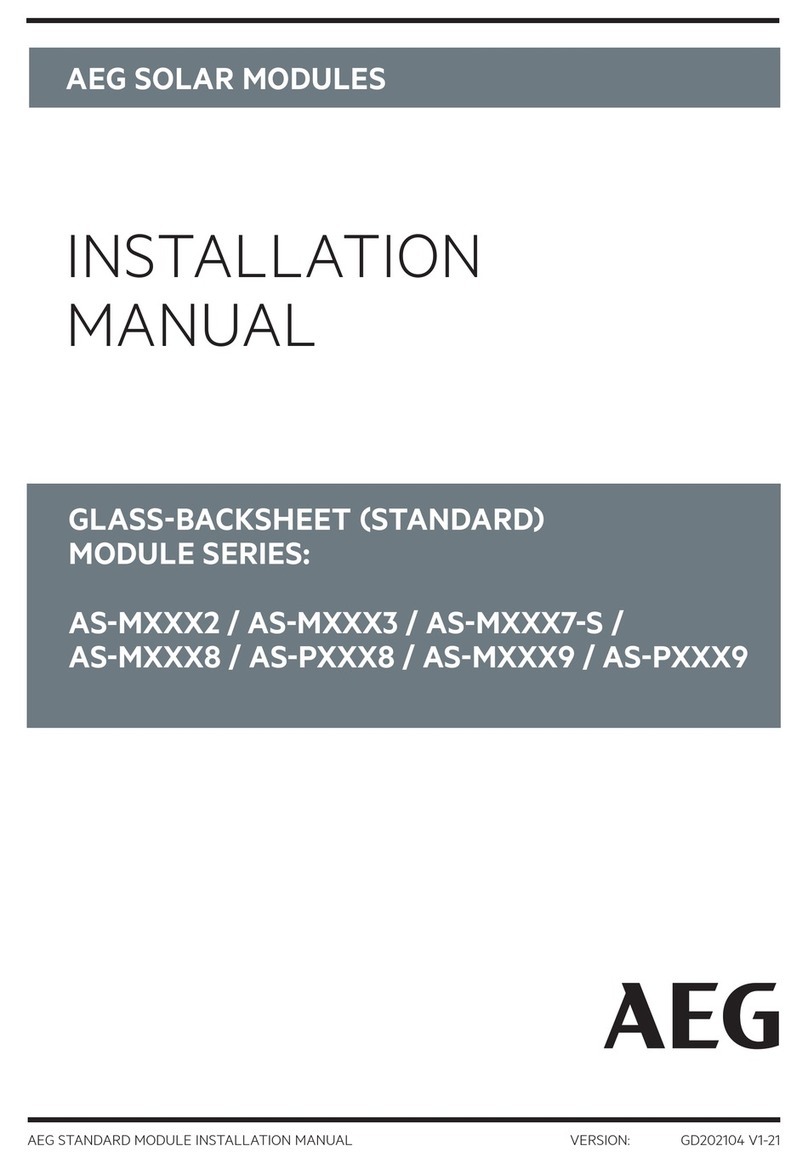
AEG
AEG AS-M 7-S Series installation manual

The Solar Trader
The Solar Trader 06003FX03 instruction manual
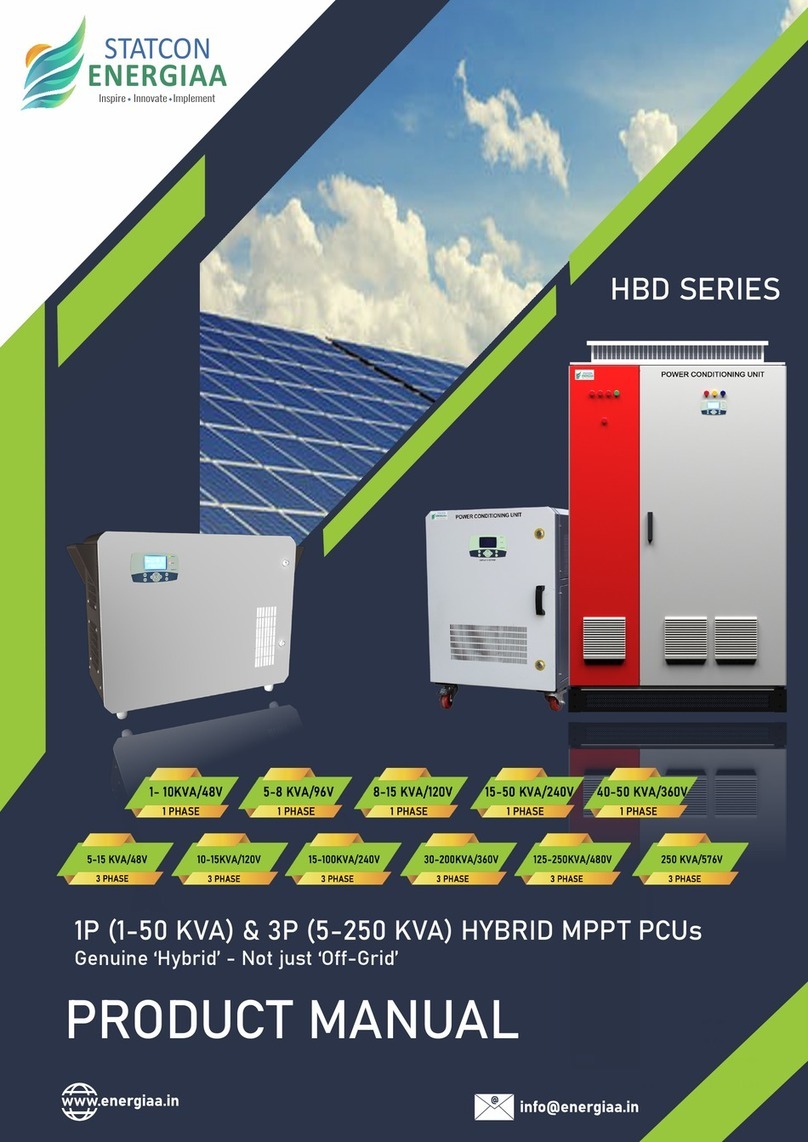
STATCON ENERGIAA
STATCON ENERGIAA HBD Series product manual
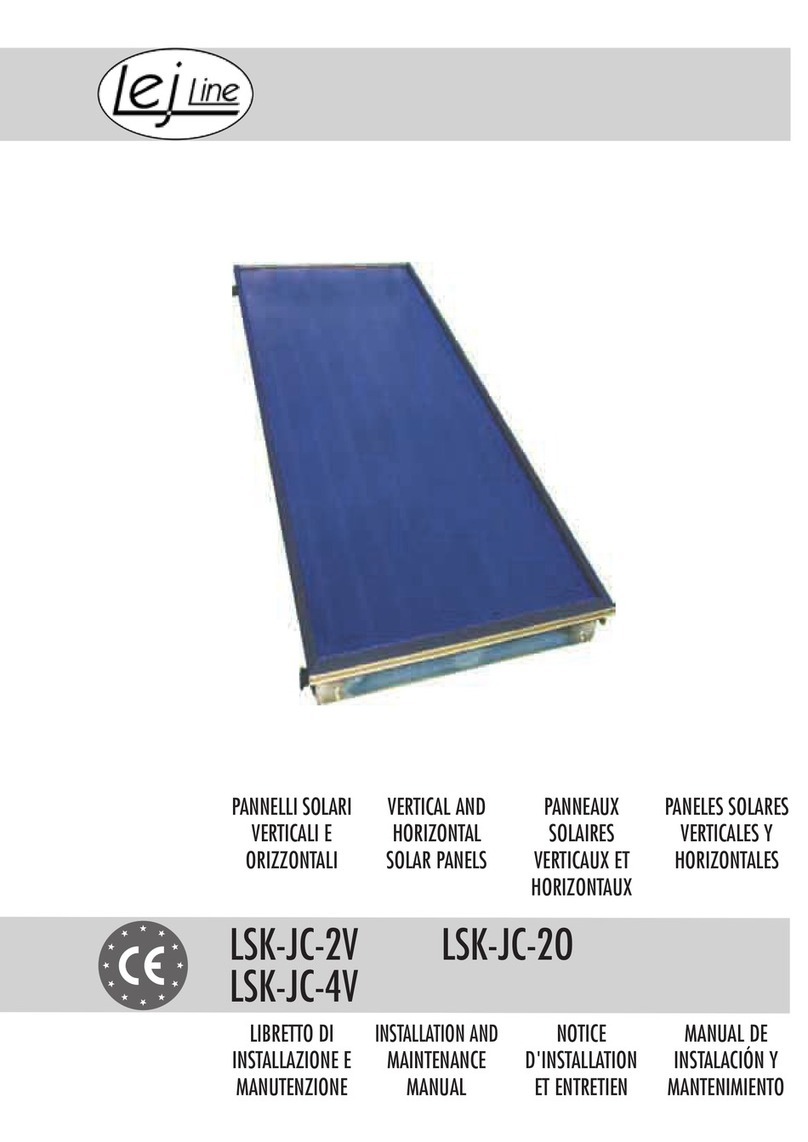
LEJ LINE
LEJ LINE LSK-JC-2V Installation and maintenance manual
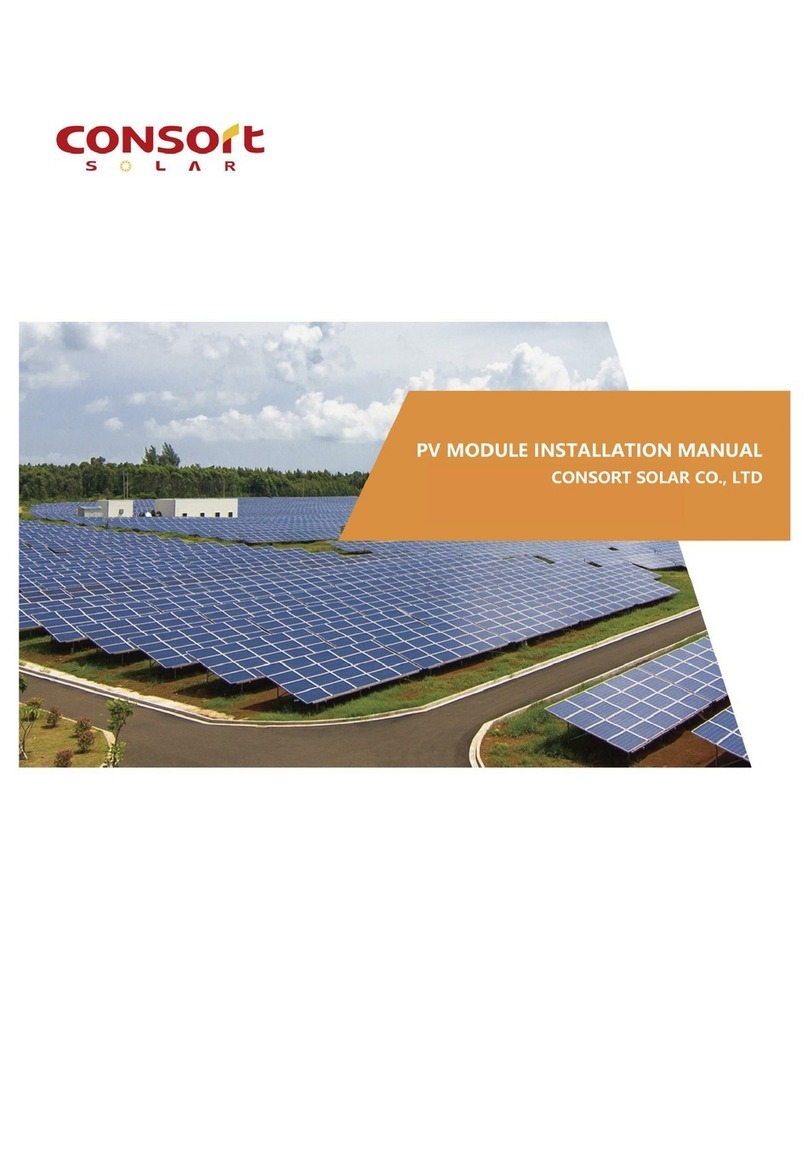
Consort
Consort CST-M10/54BH415 installation manual
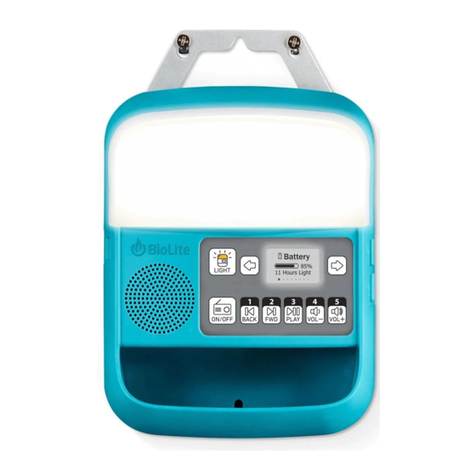
BioLite
BioLite SolarHome 620 instruction manual

